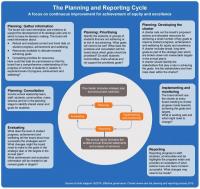You are here:
- Home »
- Using evidence for learning »
- Target setting
Target or goal setting
When students are encouraged to take responsibility for their own learning, goal setting is a logical step in the process. When achievement data, disaggregated to enable careful analysis and to set priorities, is combined with other school wide evidence (see Gathering Evidence), it is a powerful tool to help bring about change and improvement. The general principles of target or goal setting should apply at each level of the school, including goal setting by students.
Effective target setting
Target setting should focus on improving performance.
- Target setting should be based on qualitative and quantitative evidence about what is working well and what needs attention.
- Target setting can sound easy in theory but it is difficult in practice and many targets do not result in enhanced performance.
- Target setting should not be viewed as a compliance process carried out to satisfy statutory (or school leader or teacher) requirements. It is a key self-management process, and one which will drive strategic planning across the school, across a class or cohort, or for the individual.
- Effective targets need to be realistic but challenging. Targets that are too difficult and therefore unrealistic can discourage rather than motivate and those that are too easy can lead to complacency.
- Targets should not be imposed on those who have to work with them, but rather negotiated and agreed.
- Targets or goals should be SMART – that is, specific, measurable, achievable, relevant and time bound.
- Performance against targets should be monitored on a regular basis to check progress. It is important that targets are taken seriously, but it needs to be a positive process. Failure to meet targeted performance can be used to prompt learning and problem solving to improve performance.
- If targets are not met, there is still an opportunity to focus on what has been achieved, to make a rich assessment of that and share the learning where possible.
Target setting at the Board of Trustees level
The Schools' planning and reporting section on the Ministry of Education website provides information on target setting at the board of trustees level. The Develop and prepare your planning and reporting documents section of the page provides guidelines and resources to help kura or schools develop planning and reporting documents.
Target setting at the school and classroom level
School-wide target setting is best initiated at the classroom level, where teachers can identify particular students or groups of students needing a particular focus. Targets can then be established and owned at syndicate or department level, then incorporated into school-wide targets at the leadership and Board of Trustees level. This enables staff members at every level of the school to have ownership of the targets, and to take responsibility for them.
Processes should be established to monitor against targets. For example, an expectation could be:
- weekly monitoring in the classroom, using anecdotal notes, classroom observations and teacher/student conversations
- monthly reporting to syndicate leader or head of department
- term by term reporting to Board of Trustees.
These monitoring processes will be supported by the school-wide assessment schedule.
Planning for improvement
Effective target setting goes hand in hand with an action plan of how the target will be met. Planning for improvement should be done at the same time as target setting.
''We can't solve problems by using the same kind of thinking we used when we created them.''
Albert Einstein
Ask these three broad questions:
- What do we know that we can already do to achieve these targets?
- What do we need to learn to do so that we can achieve these targets?
- What will we do differently to ensure targeted improvements are made?
While change can come from short term focus on a particular area, in reality there is a limit to how much sustainable improvement can come this way alone, or just from greater effort. Lasting change will generally come from investment in professional learning and improved leadership and classroom practices.
Student goal setting process

Although the same principles apply as in class or school target setting, for most students goal setting is more effective in the context of ‘next steps in learning’ rather than very broad, long term goals. Goal setting is, however, still based on evidence, and is the logical next step that follows teacher, self or peer assessment. It's important for students to develop self assessment skills so that they are able to set their own goals. Goals that are set for students by the teacher do not have the same level of student ownership.
- The Reporting to Parents section, Student self assessment and reflection, provides information about student goal setting.
Further information
You can find further information on goal and target setting from the links below:
- Help with developing your planning and reporting documents – Develop and prepare your planning and reporting documents
- Guidance and requirements for schools' developing, submitting, and publishing your planning and reporting documents – Schools' planning and reporting requirements
- In these videos, Sharing assessment data with students, teachers at Mangere Bridge School talk about sharing assessment data to set goals with students. The videos cover:
- Sharing assessment data with students
- Sharing assessment data with students to develop their next learning steps
- Developing student ownership of their learning.


